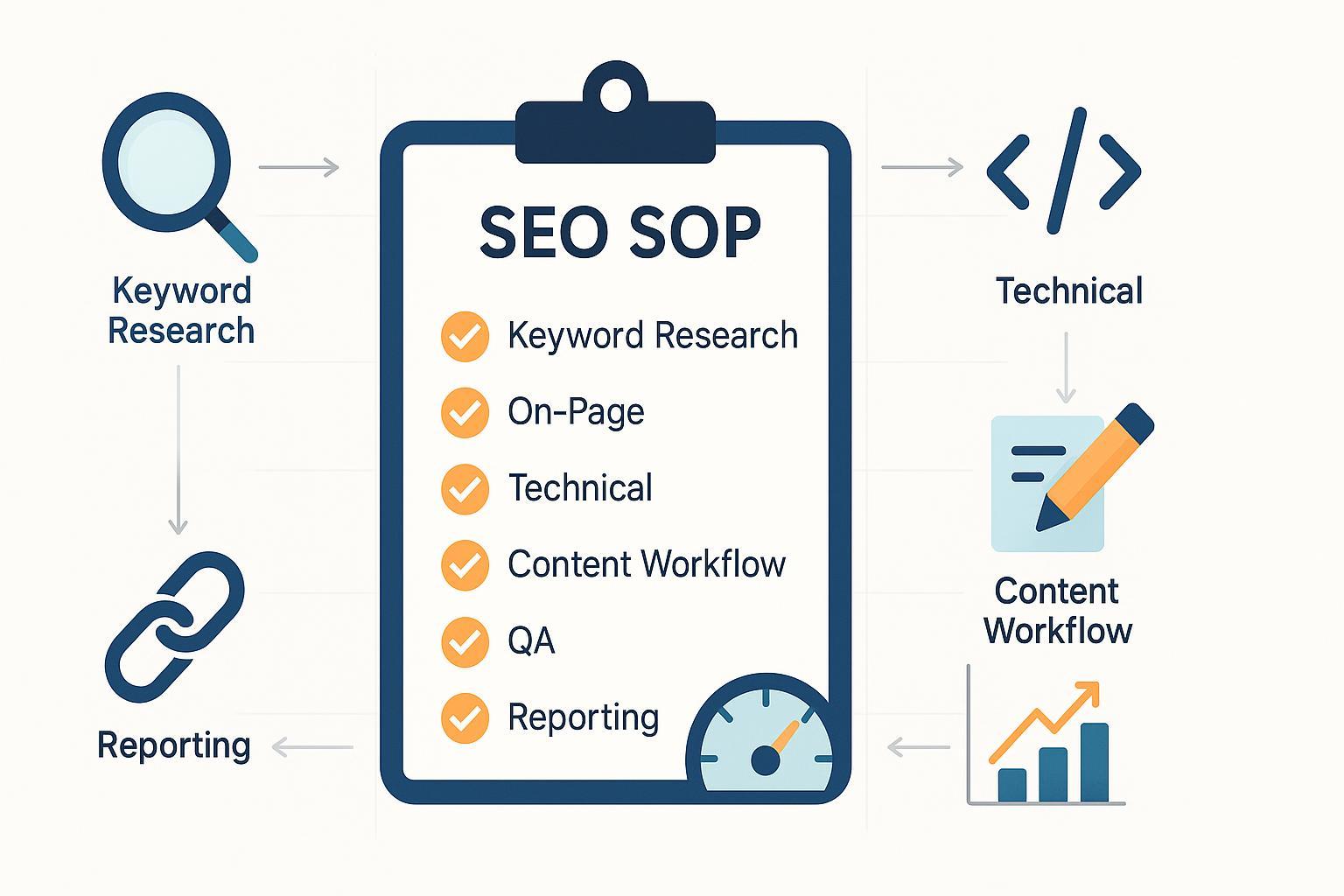How to Create an SEO SOP (Standard Operating Procedure)

If you’ve ever felt your SEO efforts are a collection of one-off tasks, an SOP turns that into a repeatable system. In this step-by-step guide, you’ll build a practical SEO SOP that aligns to your business goals and covers keyword research, on-page optimization, technical checks, content production, link building/digital PR, QA, and reporting. Expect to spend a focused day or two creating your first version, then iterate as your site grows.
What you’ll need
- A basic familiarity with SEO terms (we’ll explain the essentials as we go)
- Access to Google Search Console (GSC) and Google Analytics 4 (GA4)
- A crawler/audit tool (Screaming Frog, Sitebulb, or a SaaS audit), and a keyword tool (Ahrefs, Semrush, Moz, or your current stack)
- A shared document or spreadsheet for templates, briefs, and checklists
Tip: Keep your SOP concise. Think checklists, owner assignments, and verification steps rather than long essays.
Step 1: Align the SOP to business goals
What to do
- Identify the pages and topics that influence outcomes (e.g., product/service pages, comparison pages, high-intent blog topics).
- Define primary KPIs: organic sessions, rankings for priority keywords, CTR, conversions/events in GA4.
- Outline 2–3 quarterly themes (e.g., “improve Core Web Vitals,” “build out the pricing & comparison cluster”).
- Decide on a working cadence (weekly task review, monthly reporting, quarterly deep-dive).
Why this matters
- An SOP is only effective if it moves metrics that matter to the business.
Verification
- Your SOP intro documents business objectives and the 3–5 page types that tie to revenue or pipeline.
Helpful extension
- If you manage SEO in sprints, see this compact workflow overview: Implementing SEO sprints: quick results guide.
Step 2: Set up documentation artifacts
What to create
- Master keyword-to-URL map: keyword cluster, primary keyword, target URL, owner, status, last updated.
- Change log: date, page/section, change summary, who changed, reason, rollback note.
- Pre-publish checklist: on-page, internal links, media/alt text, schema, mobile, CWV sanity checks.
- Post-publish validation checklist: indexing request, rich results eligibility, internal link audits.
Why this matters
- Documentation prevents cannibalization, makes QA repeatable, and speeds onboarding.
Verification
- Each artifact lives in a shared location and has an owner. Add a version number and update schedule to your SOP.
Step 3: Keyword research SOP
What to do
- Define pillars and seed terms from your ICP pain points, products/services, and competitor landscapes.
- Gather keyword data (volume, difficulty, clicks) in your preferred tool; supplement with GSC query discovery.
- Cluster by SERP similarity or parent topic. Manually adjust clusters to avoid topic overlap and cannibalization.
- Classify intent for each cluster (informational, commercial, transactional; also local/video/news if relevant) by checking the top SERP results.
- Prioritize clusters by business value, intent fit, SERP features present, difficulty, and your authority gap.
- Map clusters 1:1 to URLs in your keyword-to-URL spreadsheet.
Why this matters
- Intent matching reduces pogo-sticking and improves conversions; mapping avoids duplicative pages competing for the same query.
Verification
- For each cluster, confirm the top SERP favors a specific content type (e.g., guides, product pages) and your planned page matches that format.
Troubleshooting
- If Search Console shows cannibalization (multiple URLs ranking for the same query), consolidate content and direct internal links to the stronger canonical page.
Helpful extension
- Clarify the difference between keywords and topics here: What are keywords vs. topics for SEO writing.
Step 4: On-page optimization SOP
What to do on every page
- Title and meta description
- Write a unique, descriptive title that reflects the page topic.
- Craft a clear meta description summarizing the page; aim to encourage clicks without keyword stuffing.
- For fundamentals on headings, anchor text, and structure, Google’s overview in the SEO Starter Guide is a reliable reference.
- Headings and content structure
- Use a single H1 and a logical hierarchy for H2/H3s.
- Ensure the content satisfies user intent with helpful examples, entities, FAQs, and clear answers.
- URL structure
- Keep URLs short, hyphen-separated, and descriptive; avoid parameters where possible.
- Media and accessibility
- Place images near relevant text; use descriptive filenames and alt text.
- Internal links
- Add contextual links with descriptive anchors to related pages in the same cluster; fix broken/redirected links in audits.
- Structured data
- Add JSON-LD markup that matches visible content; validate before publishing.
Why this matters
- Clear titles, descriptive anchors, accessible media, and structured data help search engines and users understand and navigate your page.
Verification
- Validate structured data in Google’s Rich Results Test, then check rendering in GSC’s URL Inspection.
Troubleshooting
- If Google rewrites your title link or shows odd anchors, revisit clarity and alignment with page content per the Starter Guide.
Helpful extensions
- Quick refresher on metadata components (TDK): Understanding and implementing TDK for SEO.
- Meta tags deep dive: Mastering SEO with HTML & CSS meta tags.
Step 5: Technical SEO SOP
What to do
- Crawlability and indexability
- Place robots.txt at the root; avoid blocking essential resources; review GSC Coverage for errors.
- XML sitemaps and canonicalization
- List canonical URLs only; keep within limits; submit in GSC; optionally reference in robots.txt.
- Ensure internal links point to the canonical version and manage parameterized URLs.
- HTTPS and redirects
- Enforce site-wide HTTPS; 301 redirect HTTP to HTTPS; sanity-check with a crawler.
- Mobile-first parity
- Ensure responsive design and content/resource parity for Googlebot Smartphone.
- Core Web Vitals (CWV)
- Monitor LCP ≤ 2.5s, INP ≤ 200ms, CLS ≤ 0.1 at the 75th percentile; review lab (PSI) and field (CrUX/GSC) data.
- Structured data
- Use supported types from Google’s Search Gallery; ensure markup matches visible content.
Why this matters
- Technical health enables discovery, rendering, and eligibility for enhanced search features.
Verification
- Review CWV in GSC and PageSpeed Insights. Validate structured data and confirm indexing in GSC.
Authoritative references
- Thresholds and CWV concepts are covered in Google’s Core Web Vitals overview. INP replaced FID in March 2024, as noted in the web.dev INP launch update (2024).
- For mobile-first best practices, see Google’s mobile-first indexing guide.
- To plan and validate markup types, start with Google’s structured data introduction.
- Build and submit sitemaps following Google’s guidance: Build and submit a sitemap.
Troubleshooting
- “Crawled – currently not indexed”: improve content quality, internal links, and confirm the canonical is correct; request indexing after fixes.
- “Discovered – currently not indexed”: strengthen internal linking and ensure the sitemap lists the canonical; remove crawl blocks.
Step 6: Content production workflow SOP
What to do
- Create briefs from your keyword clusters
- Include target intent, SERP format, outline, key entities, internal link targets, media needs, and structured data notes.
- Draft and optimize
- Write to match intent and format; cover user questions with examples and visuals; add alt text and schema.
- Review and approvals
- Editorial review for clarity and accuracy; SEO review for on-page elements and internal links; accessibility pass.
- Publish and promote
- Ensure inclusion in sitemap if you manage it manually; add the page to internal link hubs; share via your owned channels.
- Refresh cadence
- Quarterly for top pages; at least annually for evergreen content; log changes in the change log.
Example tooling in practice
- You can use QuickCreator to generate briefs, draft posts aligned to intent, enforce on-page elements, and run content quality scoring during QA. Disclosure: QuickCreator is our product.
Verification
- Run your pre-publish checklist on titles/meta/H1, URL, internal links with descriptive anchors, image alt text, schema validation, mobile readiness, and a PageSpeed Insights lab test for CWV sanity.
Troubleshooting
- Bottlenecked reviews: standardize the brief and checklist, assign owners, and prioritize pages tied to business goals.
Helpful extension
- If you prefer AI-assisted drafting and workflows, see the AI blog writing modes documentation for process options and guardrails.
Step 7: Link building and digital PR SOP (policy-compliant)
What to do
- Prospecting
- Focus on relevant, authoritative sites and earned formats (expert insights, data stories, partnerships, resource pages).
- Outreach
- Personalize pitches around value; avoid manipulative tactics or link schemes.
- Attributes and policies
- Use rel="sponsored" for paid/affiliate, rel="ugc" for user-generated content, and rel="nofollow" for unendorsed links; Google treats these as hints.
Why this matters
- Ethical, policy-aligned acquisition reduces risk and builds durable authority.
Verification
- Log outreach, vet referring domains, and confirm correct rel attributes on placements.
Authoritative reference
- See Google’s link spam policy and qualification guidelines: Search Essentials link spam policies and qualify outbound links.
Step 8: QA, post-publish validation, and reporting SOP
Pre-publish QA checklist
- Titles/meta/H1 present and unique; URL is clean and descriptive
- Internal links added with descriptive anchor text; no broken links
- Images have descriptive filenames and alt text
- Structured data validates; mobile rendering is clean
- PageSpeed Insights lab test shows no severe regressions
Post-publish validation
- Request indexing via GSC URL Inspection
- Confirm rich results eligibility in GSC (where applicable)
- Audit internal links to the new page and add links from relevant hubs or pillar pages
Reporting and cadence
- Weekly/biweekly: monitor impressions, clicks, CTR, average position in GSC; check coverage and CWV status for key templates
- Monthly: summarize outcomes and insights; note changes made and planned
- Quarterly: perform a deep-dive, review clusters, refresh top performers, and update SOP version if needed
Authoritative references
- For performance tracking, use GSC’s Performance report: Google Search Console Performance.
Optional analytics setup
- In GA4, mark conversion events and link GSC/GA4 for easier analysis; see GA4 conversions overview and Google’s integration description in their monitoring guidance.
Helpful extension
- To evaluate content quality during QA, see the Content Quality Score tool documentation.
Adaptations for team size and tool budget
Solo/SMB
- Use a single shared spreadsheet and a lightweight crawler (Screaming Frog). Prioritize your top 10 URLs and 5 clusters. Keep the SOP to one page plus checklists.
Growing team
- Add template briefs, change logs, and owner assignments. Automate weekly audits and use dashboards for CWV/GSC. Run quarterly SOP reviews and refreshes.
Agency
- Standardize briefs across clients, enforce pre-publish QA, and maintain change logs. Use project management to track sign-offs and refresh cadences per client.
Tool alternatives
- Research: Ahrefs/Semrush/Moz; free discovery via GSC queries
- Audits: Screaming Frog, Sitebulb, Semrush Site Audit; PSI and web.dev for CWV
- Dashboards: Looker Studio for reporting, GSC/GA4 exports for deeper analyses
Putting it all together
Your SEO SOP should be a living document. Start with the eight steps above, plug in your artifacts (keyword map, checklists, change log), and set a realistic cadence. As your site evolves and Google’s guidance updates, revise the SOP version and keep the team aligned.
If you want a streamlined way to generate briefs, create high-quality drafts, and run content quality checks inside one workflow, you can try QuickCreator in your next sprint.
Reference index (official docs)
- Google: SEO Starter Guide
- Google: Core Web Vitals overview
- web.dev (Google): INP replaces FID — launch update (2024)
- Google: Structured data introduction
- Google: Rich Results Test
- Google: Build and submit a sitemap
- Google: Mobile-first indexing best practices
- Google: Search Essentials link spam policies
- Google: Qualify outbound links
- Google: Google Search Console Performance
- Google: GA4 conversions overview

